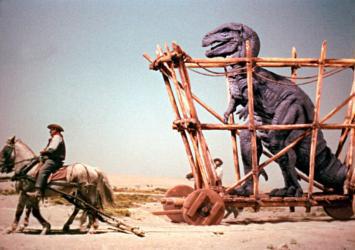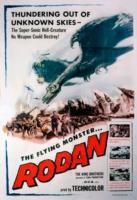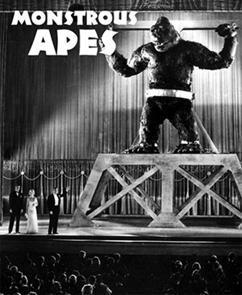The Valley of Gwangi [Jim O’Connolly, 1969]
Based on an original, unproduced script by Willis O’Brien, Harryhausen finally realized his mentor’s vision and put cowboys and dinosaurs together in the Old West. Here, the captive Gwangi is being transported to be put on public display.

“It’s disgraceful to think of putting this fabulous creature on display in a cheap circus.”
Professor Bromley (Laurence Naismith) in The Valley of Gwangi[1969]
Dragons & Dinosaurs[ Book Contents]
Rodan! The Flying Monster! [Ishirô Honda, 1956]
Ishirô Honda is at it again! Tagline: “The Super-Sonic Hell-Creature No Weapon Could Destroy!” Rodan looks much less like a European dragon than the poster portrays him.


King Kong[Merian C. Cooper, Ernest B. Schoedsack, 1933] King Kong crucified and on display for a Broadway theater audience. Left to right: Bruce Cabot, Fay Wray, Robert Armstrong, and Kong, the Eighth Wonder of the World!
MONSTROUS APES
In King Kong[Merian C. Cooper, Ernest B. Schoedsack, 1933], theatrical showman Carl Denham (Robert Armstrong) has captured the giant ape, brought him to Manhattan, and billed him as “The Eighth Wonder of the World.” The opening-night audience thrills with anticipation waiting for the curtain to rise on what promises to be the Broadway sensation of the decade. Two women wonder what Mr. Denham has in store for them this time. One remarks that she heard it was “some kind of gorilla.” As two men climb over them on their way to their seats, the other woman replies, “Ain’t we got enough of them in New York already?”
King Kongis the greatest fantasy film of all time. When Ray Harryhausen saw King Kongat Grauman’s Chinese Theater on Hollywood Boulevard, he was stunned by Willis O’Brien’s stop-motion animation of Kong and the prehistoric denizens of Skull Island. O’Brien became Harryhausen’s mentor and hired him to assist on the later stop-motion gorilla picture, the romantic Mighty Joe Young[Ernest B. Schoedsack, 1949].
What is it about apes and particularly gorillas that makes them the go-to monster for the movies? Even haunted-house comedies always had a guy in a gorilla suit running around.
Monkeys have obvious similarities to human beings, something that has fascinated people for centuries. But gorillas themselves are relatively new to us. When the first gorilla cadaver was stuffed and brought to Europe from Africa in the late 1840s, the ape’s massive size and obvious power shocked many people. Popular books, like Paul du Chaillu’s Stories of the Gorilla Country[1867] helped to create the myth of gorillas as ferocious raiders, carrying off women from native villages. This theme of the gorilla as rapist became a popular motif in western art: the French sculptor Emmanuel Frémiet’s bronze Gorilla Carrying off a Womanwon the Medal of Honor at the Paris Salon in 1887. Popular culture, including the movies, has continued to perpetuate the image of the rampaging giant ape, even though gorillas in the wild are the gentlest of herbivores.
Chimpanzees are known for their intelligence and “human-like” behavior. However, as adorable as baby chimps are, they grow up to be very big and very aggressive animals. Nevertheless, what audiences demanded were gorillas.
Filmmakers soon realized that putting a man in a gorilla suit was far more practical than working with a real gorilla. And soon a special breed of performer (often supplying their own ape suits) began playing gorillas in thrillers, horror films, and comedies.
Names like Emil Van Horn, Charles Gemora, George Burrows, Ray “Crash” Corrigan, and Bob Burns may not be familiar names nowadays, but their gorilla suits are, for each actor had his own, instantly recognizable one.
Gorilla suits were often more valued than the performers who owned them. The B-movie producer Herman Cohen was too cheap to fly ape-performer George Burrows to London to wear his gorilla suit for Konga[John Lemont, 1961], so Burrows reluctantly agreed to rent it to the production. The suit was worn by an unknown British stunt man.
Kongais a particularly wacky movie. Botanist Michael Webber (an over-the-top Michael Gough) injects a chimpanzee (portrayed by a real chimpanzee) with a serum that somehow changes the chimp into a highly aggressive gorilla. Webber’s jealous girlfriend/assistant injects more serum into the chimp/now gorilla which causes it to grow big enough to rampage around London, destroying Tower Bridge and Big Ben in the process. George Burrows was furious when producer Cohen returned his gorilla suit heavily damaged by the miniatures and pyrotechnics used by the British crew. But perhaps Burrows’ gorilla suit’s lowest moment was when he wore it as the space monster Ro-Man in Robot Monster[Phil Tucker, 1953]. The ape body was used, but the head replaced by an extremely silly helmet, which can only be described as a goldfish bowl with an old TV antenna on top.
Crash Corrigan (and his costume) played the gorilla in The Bride and the Beast[Adrian Weiss, 1958]. The typically weird Ed Wood screenplay concerns a woman who must chose between her husband and a gorilla! The title character in The White Gorilla[Harry L. Fraser, 1945] is Crash Corrigan again, but this time his suit was dyed snow white. With his gorilla suit already dyed, Corrigan quickly appeared in the title role of White Pongo[Sam Newfield, 1945] as an albino gorilla who might just be the Missing Link. Corrigan’s gorilla also turns up in Captive Wild Woman, The Bowery Boys Meet the Monsters[Edward Bernds, 1954], and one of the few films directed by screenwriter Curt Siodmak, Bride of the Gorilla[1951].
Charles Gemora worked as a special-effects man at Paramount Studios for many years, with a sideline performing in the gorilla suits he used to design and manufacture. Gemora took care to make his suits as realistic as possible. He gives one of the great gorilla performances in The Monster and the Girl[Stuart Heisler, 1941], a peculiar mixture of mad-scientist, brain-transplant, gangster, and boy-and-his-dog movie that is one of my favorites. Gemora also played the murderous gorilla in Murders in the Rue Morgue[Robert Florey, 1932] and fooled around with the Marx Brothers in At the Circus[Edward Buzzell, 1939]. One of the crazier moments in the films of Laurel and Hardy is in Swiss Miss[John G. Blystone, 1938] when Stan and Ollie are trying to carry an upright piano across a narrow wooden suspension bridge high over a canyon in the Swiss Alps, and Gemora’s gorilla tries to cross in the opposite direction! After a struggle, the gorilla falls off the bridge, only to turn up at the very end of the movie on crutches, with his head bandaged and his leg in a plaster cast, and chase our heroes off into the sunset. Most wonderful of all is when Gemora’s gorilla lumbers onto the stage in the glamorous nightclub in Blonde Venus[Josef von Sternberg, 1932] and removes his gorilla hands and then head to reveal Marlene Dietrich in a blonde Afro wig!
Emil Van Horn was another renowned gorilla impersonator. He had a less realistic costume than Gemora, but he performs energetically in The Ape Man[William Beaudine, 1943], co-starring with Béla Lugosi. He also makes a memorable appearance in W. C. Fields’ surreal Never Give a Sucker an Even Break[Edward F. Cline, 1941].
Various studio make-up and costume departments manufactured ape suits over the years. But with “special effects make-up man” Rick Baker, the gorilla suit reached new levels of sophistication. His suit for the Bigfoot named Harry in Harry and the Hendersons[William Dear, 1987] was worn by Kevin Peter Hall, the very tall actor who later portrayed the Predator in Predator[John McTiernan, 1987]. Baker used remote radio controls to work the facial features on Harry which, combined with the terrific mime of Kevin Peter Hall, created a remarkably realistic character.